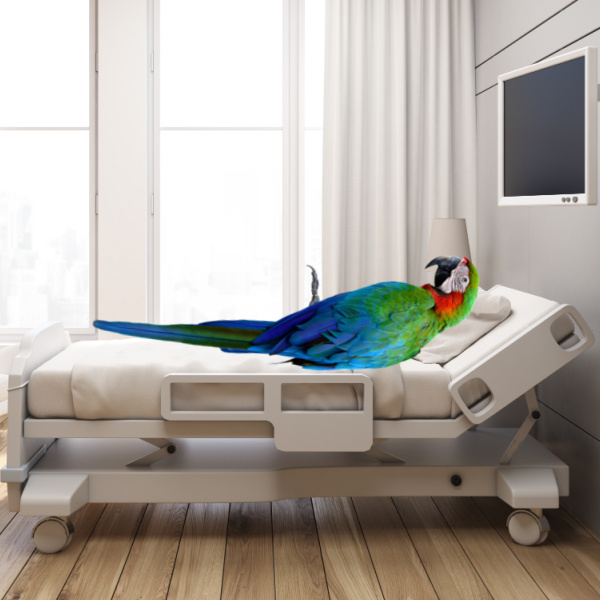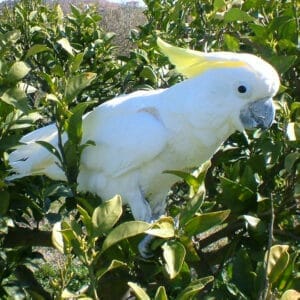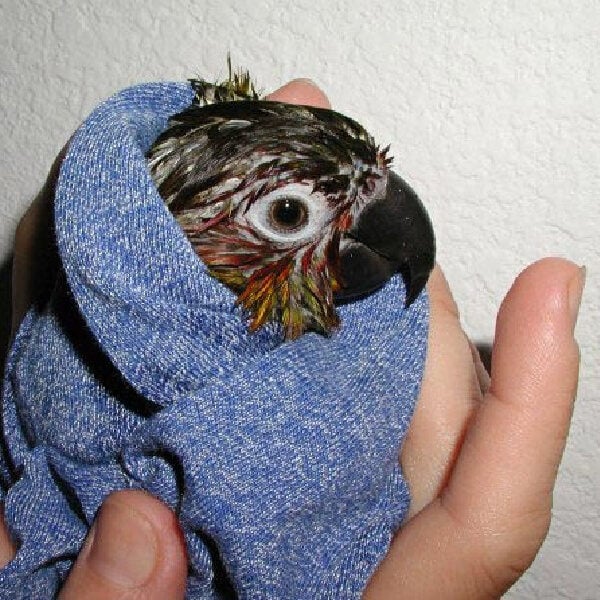Last Updated on by Mitch Rezman
One day I’ll stop apologizing for stepping on toes. Although I have great respect for my esteemed associate who answered this question previously (on Quora) I have a totally different point of view.
The most influential factor in determining the lifespan of any companion bird in captivity, in and of itself – is daylight and the daily duration of light vs darkness.
50 million years of hard wiring for an animal to believe that he or she can go where they want, anytime, changes the moment they occupy a birdcage.
Unfortunately, many captive birds die of malnutrition. Many captive bird owners mistakenly believe that human food in the form of something called “chop” can replace commercial bird food that has been researched and produced under exacting conditions for dozens of years. There is also a misconception about seed diets, according to Mark Hagen. (The creator of Hagen bird food has a Masters’s Degree in agriculture)
Baby Budgies Growth Stages ~ Video
“The most dramatic nutrient problem with seed-based diets is not their deficiencies, which can be met with supplements, but their excesses of fat which can not be removed prior to feeding. Fat levels in the three most commonly eaten seed kernels are so high that these seeds are referred to as “oilseeds”.
Although safflower is a smaller and less palatable oilseed than sunflower, its fat content is, in fact, higher than sunflower. All birds may not like the bitter taste of safflower and thus tend to eat a larger variety of seeds when eating a diet based on it.
Withholding seeds from a bird deprives them of the texture they enjoy on their tongue as well as different tastes. We talk about foraging and enrichment which I’ll get to in a moment, but without providing large seeds and nuts to an African grey parrot, or parrots in general, the birds are missing out on doing natural tasks like cracking the shell on a hazelnut.
Now let’s circle back to nutrition. The majority of experts are great proponents of a pelleted diet, Something that supposedly will extend a bird’s life expectancy. Full transparency, I am an internet retailer of bird supplies (we sell no livestock just the supplies).
We currently offer 19 brands of bird food all for captive birds and for 15 years I have been reading labels while entering them into the internet (our website) so I’m familiar with the ingredients of not only the commercial bird foods that we sell but our competitors and the ones we don’t sell, for reasons of our own.
Naming Harrisons & Kaytee in the same sentence is like comparing aged prime beef to taco meat.
That said, Harrison’s contains toasted soybeans. Soy Has been shown to be a plucking trigger and plucking is a common behavior found in African grey parrots.
Hagen Alternative Formula pellets contain no soy or corn that may help with birds who pluck.
That is why we sell 19 brands of bird food which still really isn’t enough because we have to satisfy the dietary requirements of close to 700 + species of captive birds many with unique digestive systems.
Most Captive Bird Keepers neglect to offer the birds food with an enrichment delivery system. Birds are hardwired to work for food. You can change food a dozen times but it all looks the same to them. Many birds when offered unlimited food in an exposed bird food dish versus food that is much more difficult to get to will select higher levels of difficulty to feed themselves – because they are birds.
Let’s shift gears and talk about lighting. EVERYONE gets lighting wrong. I will debate anyone publicly on this subject be it a behaviorist or a veterinarian. No one takes into account when talking about lighting two issues that are at the core of captive bird care.
The Inverse Square law of light (an absolute physics law) and circadian rhythms. Let’s start with the inverse Square law which I write about in detail here Let’s say you have two 25-watt fluorescent tubes in the ceiling emitting a combined 3000 lumens over a bird cage.
If the ceiling is 8 feet tall and the cage is six feet tall here’s the math: 3000 lumens are emitted at the source which is the ceiling. 1 foot away, halfway between the ceiling and the cage, it is receiving 1500 lumens. The Top of the cage at six feet is receiving 375 lumens and one foot down from the top of the cage, 3 feet from the ceiling the bird is receiving about 94 lumens of the original 3000 lumens coming from the ceiling.
The moral of the story is, to get any sort of benefit it is important to have lighting no more than a foot but closer to, 6 inches above the cage. This doesn’t have to cost a lot of money. We sell a bird light bulb for as little as $12 that feels great to the birds. They do not emit UVA or UVB. We can sell you a full-spectrum bulb with UVA and UVB for between $22 and $30 but the addition of UVA and UVB is not going to improve your bird’s quality of life nor is it going to help your bird produce more vitamin D.
We get a lot of phone calls asking about Full Spectrum Lighting because they want to help their bird and improve their vitamin D. My first question is always “How do you know your bird is vitamin D deficient? Have you had a full blood screen work-up that indicates any vitamin deficiencies if you have not you’re only guessing?
“If you want to improve vitamin deficiencies it’s best to do it nutritionally.”
Let’s talk about that circadian rhythm thing. This just blows me away because nobody talks about how Captive Bird Keepers will spend thousands to get the bird to stop plucking. They will whine about their bird screaming, but they won’t spend $12 on a timer to emulate equatorial light cycles.
Birds’ lighting should be direct and on top of their cages attached to a timer. Our birdcage lights come on at 8:30 in the morning regardless of daylight savings time which we do not respect. That indicates to them the day has started. The budgies rarely come out of the cage but our Senegal is out most of the day. She’s returned to the birdcage five or ten minutes before the light goes out on top of her cage signaling to her the precise end of the day.
Without providing these light signals to our birds they may molt and get hormonal, at arbitrary times. Without consistent light cycles, they are confused and very stressed out which can lower the life expectancy of an African grey or any captive bird for that matter.
Many of you may have heard of SAD – Seasonal Affective Disorder. It’s a human depression related to the change in seasons and usually happens to start in fall and running through winter. Treatment for SAD can include light therapy (phototherapy) according to the Mayo Clinic. It’s a real disorder.
Why then do we assume our birds with a much greater sensitivity to light are immune to some sort of avian SAD? The fact is they are not! If we get our bird’s light cycles in order other positive behaviors will begin to fall into place.
If you want to learn more about the science of The bird of time: cognition and the avian biological (circadian) clock click here
The temperature of a parrot’s physical environment is important but doesn’t need to be overstated. We live in an 1800-square-foot apartment with nine-and-a-half-foot ceilings meaning that the furnace has to heat more than 17000 cubic feet.
We choose to keep the thermostat set to 65 in the winter but all the birds have heated thermal perches and or heated cage panels as well as oil-filled electric radiator heaters next to each bird cage providing necessary warmth year-round. Heat the cage, not the home.
Generally speaking, if you are warm your parrots are warm and if you are cold your parrots are cold which makes your bird’s comfort zone easy to determine.
In summation, it’s important to look at any bird’s environment holistically. Meaning: nutrition – cage environment – lighting/light cycles – out of the cage environment – clipped or flighted – training – sexuality – species – foraging/enrichment opportunities – exercise – frequency of bathing – other feathered flock members – human flock members.
You will not solve your bird’s problems by reading answers on Quora, watching a couple of webinars, or googling questions while working through endless YouTube videos. What you are facing is dealing with an animal having the intelligence of a 3-year-old autistic child in a feather suit…forever.
If you’re not ready to make that commitment – get a hamster not a bird.
Typically, when you purchase a budgie from a pet store, you can expect it to be less than a year old..
Written by Mitch Rezman
Approved by Catherine Tobsing
Author Profile
Latest entries
 The Traveling BirdJune 26, 2025Can You Name 5 Parrot Species That Are Living Wild in the USA?
The Traveling BirdJune 26, 2025Can You Name 5 Parrot Species That Are Living Wild in the USA? Bird BehaviorJune 26, 2025How is it Parrots Are Problem Solvers Social Animals and Even Use Tools?
Bird BehaviorJune 26, 2025How is it Parrots Are Problem Solvers Social Animals and Even Use Tools? Bird & Parrot AnatomyJune 25, 2025How a Tiny Chemical Modification Makes Parrots Nature’s Living Paintings
Bird & Parrot AnatomyJune 25, 2025How a Tiny Chemical Modification Makes Parrots Nature’s Living Paintings PigeonsJune 20, 2025How Do Parrots Thrive in Cities Outside Their Native Habitats?
PigeonsJune 20, 2025How Do Parrots Thrive in Cities Outside Their Native Habitats?





Sherry Langevin
22 Apr 2017ok Mitch, asking—-what is your recmmendation of the best kinds of food to give my african grey (who I have loved/obsessed over for almost 26 years?) Each decade new info. comes out about feeding, behavior, etc that sometimes opposes what the last decade has embraced. I live on a small amount of money; I have tried different pellets throughout the years, and tell you that Arlo doesn’t like them and won’t eat them unless really hungry for something. No, I have not starved her. Also, I see the ingredients on these pellets (a couple of them even my vet recommends, and he doesn’t make money selling them) and always ‘corn’ and ‘soy’ plus other crap in them. What? What do I give my parrot? I already give her veggies, fruit (some, not alot) cooked grains and sometimes a bone with bit of cartiledge (yes, I’m horrible owner, she likes it) I even have tried ‘nutriberries’ and they don’t work either. What is the answer?
sincerely,
Sherry and please don’t be rude or nasty…..I have stopped using some FB pages, due to how nasty ‘experts’ (those who have owned a bird for 6 months to 3 years) are …. Love your info and how you send it out.
WindyCityParrot
24 Apr 2017Sherry – the problem is not the food – birds can’t tell the difference between pellets for the most part – your issue is not the choice of food but the delivery system – please watch this video for what I’m talking about – birds are hard wired to work for food – not eat out of bowls
Even if your bird does not pluck or scream it will most likely choose to work for food.I have other videos with simpler ” foraging boxes” if you are interested
https://www.youtube.com/watch?v=DgLd5nUR55Q&t=41s
Sherry Langevin
24 Apr 2017oh, I have bought a few of those foraging things, and made some simple ones myself. Mostly, I was referring to all of the pellets, and how it’s usually corn or soy, and it is so frustrating. I use those things on and off; she seems to be interested in them sometimes and sometimes not. It’s not always the same presentation (food I mean)
WindyCityParrot
24 Apr 2017https://windycityparrot.com/goldenfeast-c-484_349/goldenfeast-goldnobles-i-peanut-free-corn-free-10-lb-45-kg-p-3081.html is corn free –
https://windycityparrot.com/tops-c-484_629/tops-bird-food-pellets-for-all-size-hookbill-parrots-10-lb-455-kg-p-3049.html is corn free and soy free
we’re learning more about soy and it’s potential negative implications
Dianne Yonan
23 Apr 2017So what is the best light cycle. You mention your lights come on at 8:20, when do they go out? and do you keep the same hours year round? I would love to know.
Catherine Tobsing
24 Apr 2017off at 8:20 and we do not respect daylight savings time thus emulating equitorial ligh cycles
Lara Wilson
24 Apr 2017First off, thank you for responding to my question regarding full spectrum lighting last week. I really appreciate the time you spend helping us bird parents weed through the myths and facts of parrot ownership.
I have one question for clarification… If I am reading your article right, you are saying the full spectrum lighting should be on a timer and on ALL day? I ask because the bird supply store I purchased my bulb from said it needs to be on for only 2-4 hours per day for a south american parrot. This is quite a spread of a time difference! I understand why it should be on all day–to mimic a natural daytime schedule–but am so confused as to what I was advised before.
Also, should I worry about parrot cataracts with FSL?
I thank you and my Pionus thanks you!
Catherine Tobsing
24 Apr 2017You’re welcome – 2 -4 hours a day of artificial light may have an impact on reptiles but would be of no use for birds.
Birds circadian rhythm is based on a 12/12 light cycle signaling to the pineal gland and deep brain photo receptors triggering the release of meletonin.
Our information come from working with http://hari.ca/ and http://ovc.uoguelph.ca/ not just anecdotal solutions
This article is pretty technical but begins to explain the science behind avian circadian rhythms https://windycityparrot.com/blog/2017/04/20/the-bird-of-time-cognition-and-the-avian-biological-clock/
hope that helps